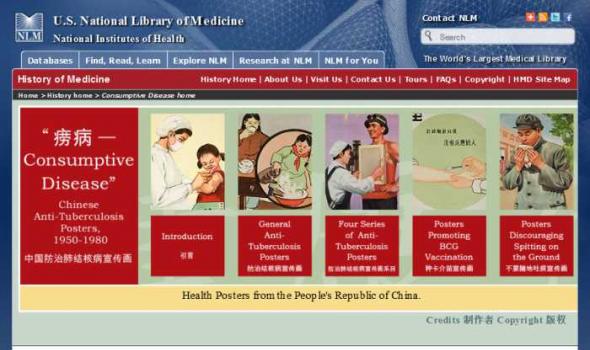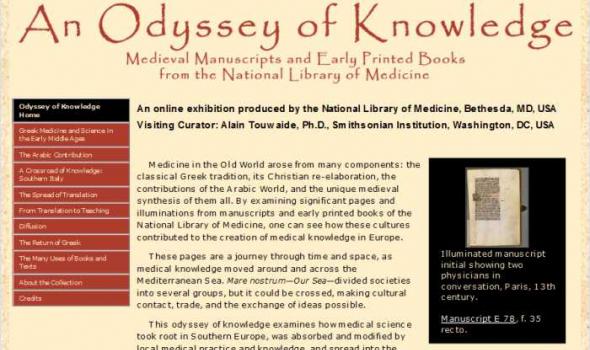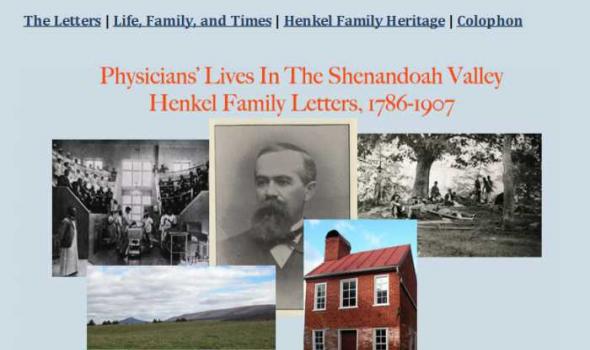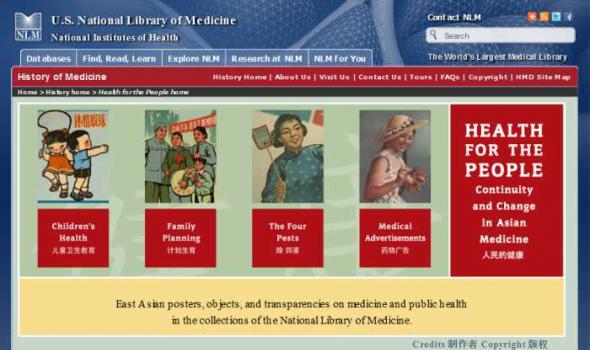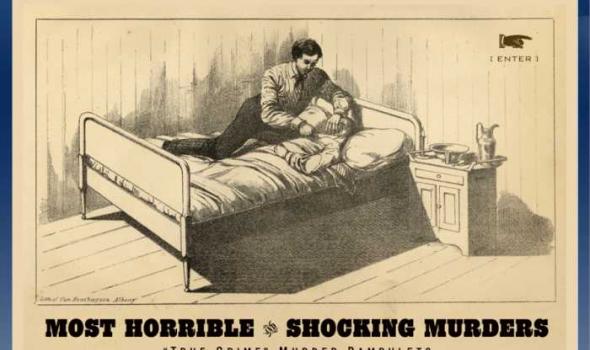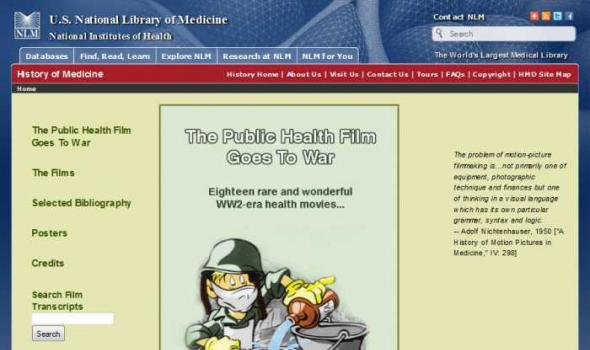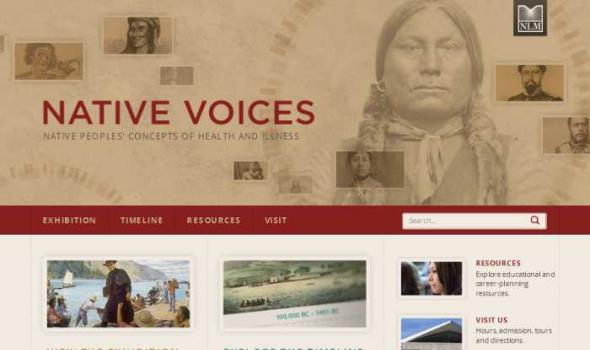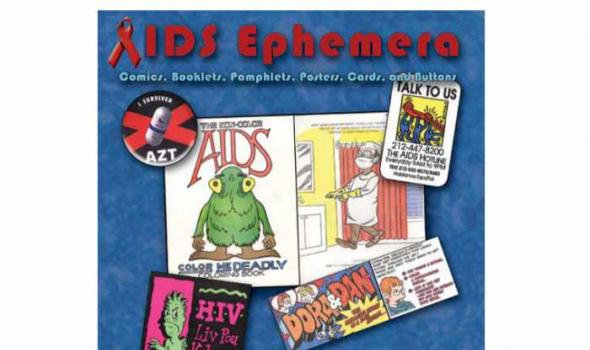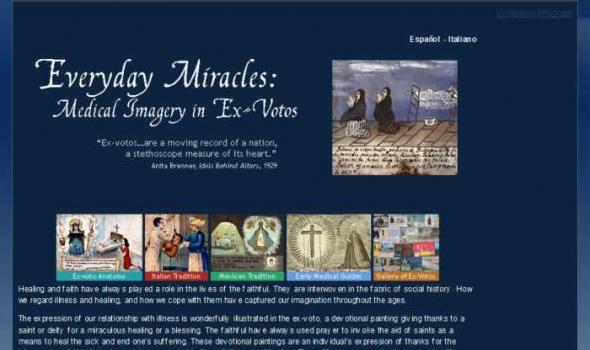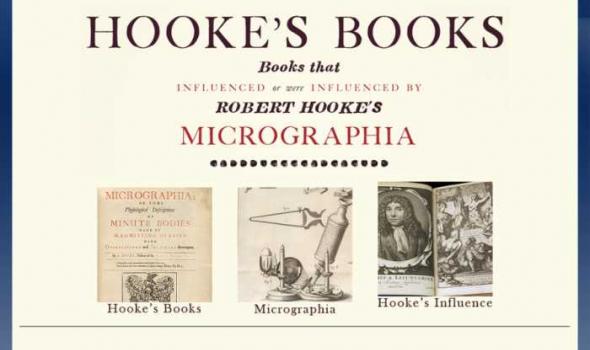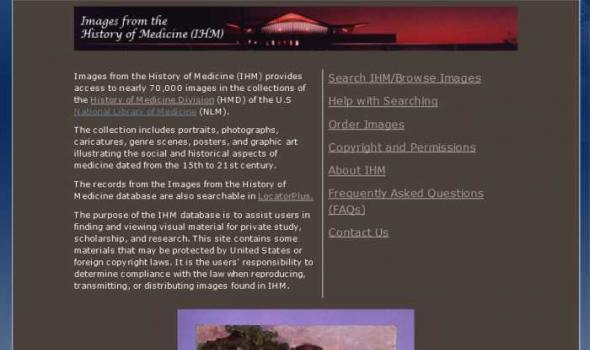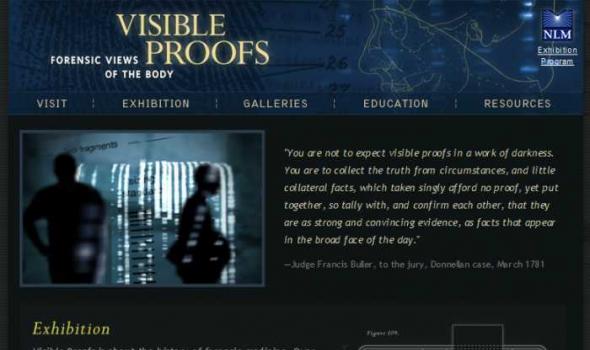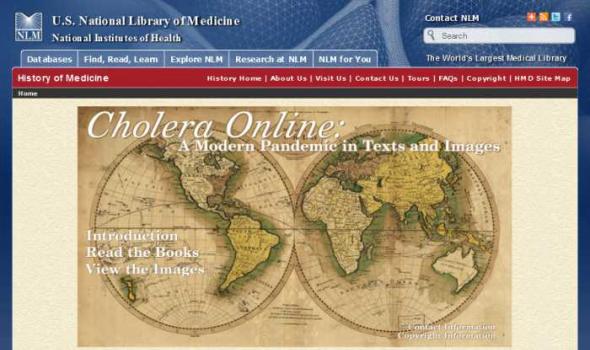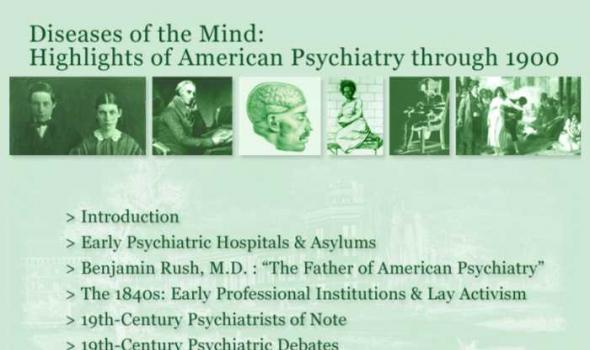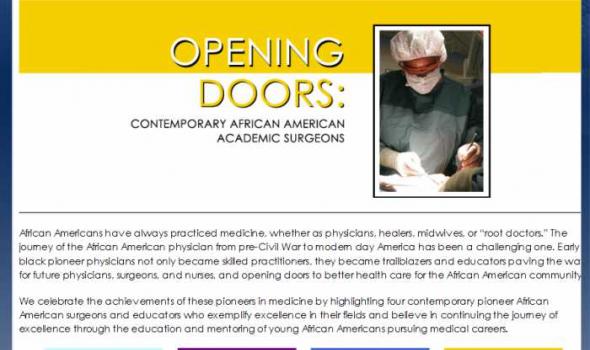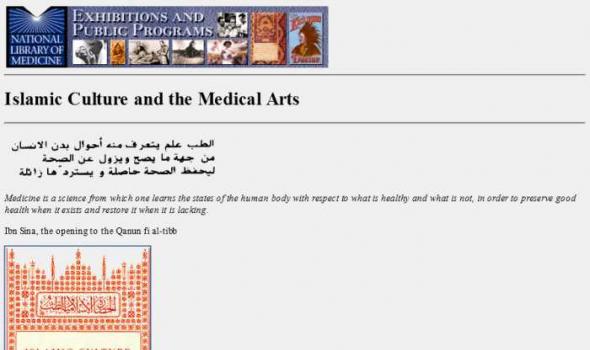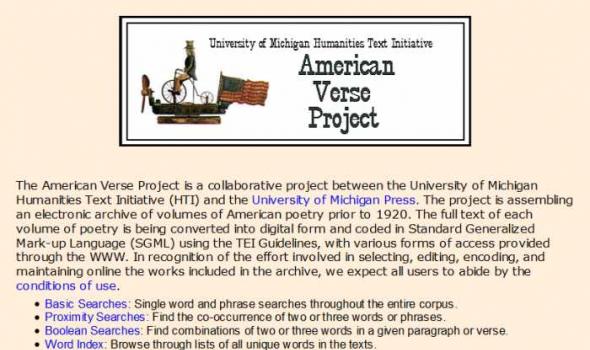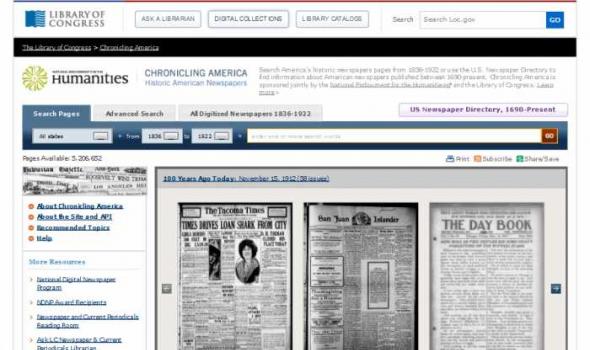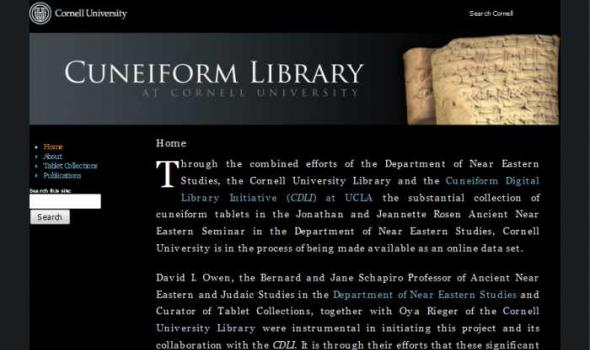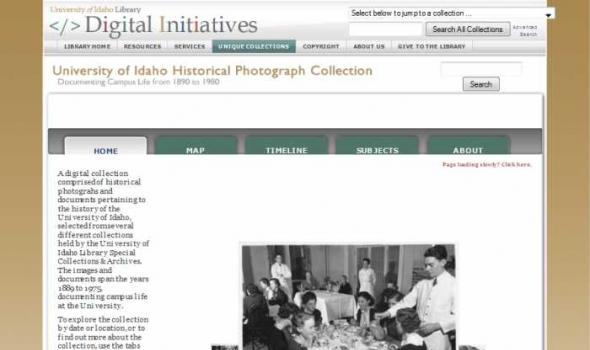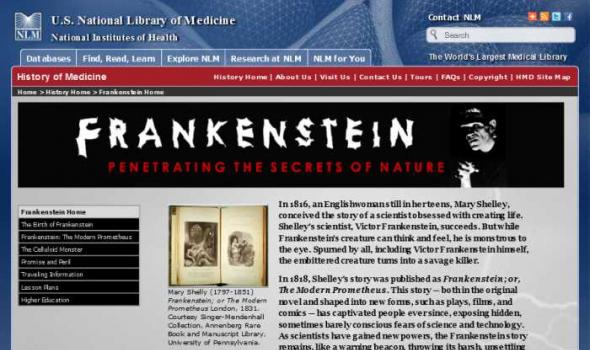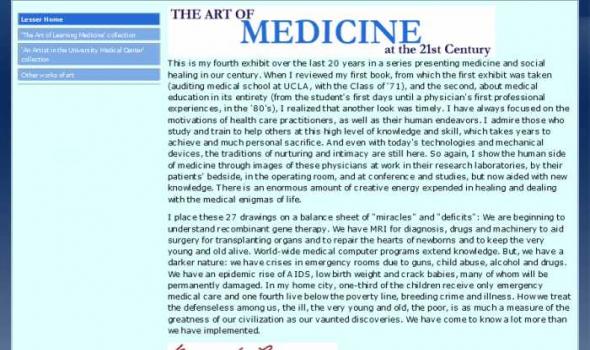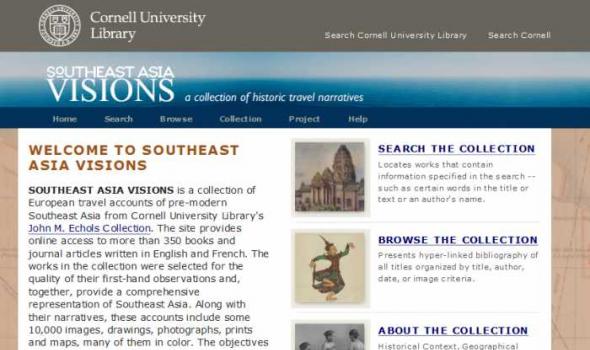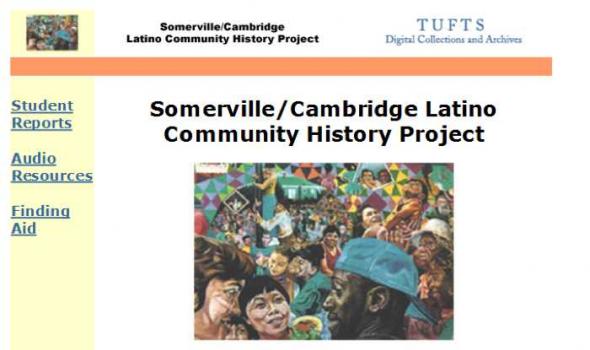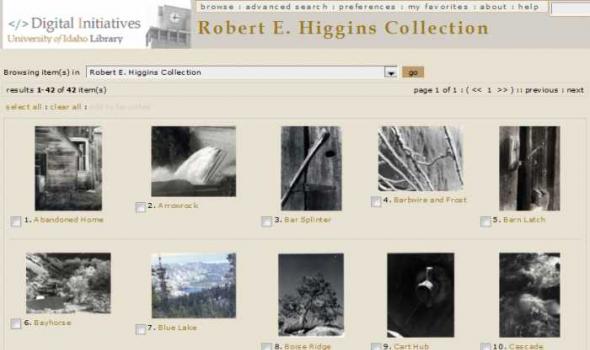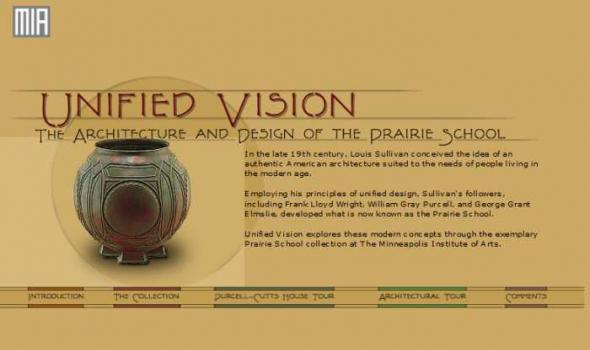U.S. National Library of Medicine
History of Medicine About a hundred years ago, public health took a visual turn. In an era of devastating epidemic and endemic infectious disease, health professionals began to organize coordinated campaigns that sought to mobilize public action through eye-catching wall posters, illustrated pamphlets, motion pictures, and glass slide projections. Impressed by the images of mass media that increasingly saturated the world around them, health campaigners were inspired to present new figures of contagion, and recycle old ones, using modernist aesthetics, graphic manipulations, humor, dramatic lighting, painterly abstraction, distortions of perspective, and other visual strategies.
History of Medicine Introduction 引言 Tuberculosis was one of the major epidemic diseases in 20th-century China, along with smallpox, malaria, cholera, schistosomiasis, and other epidemics. Organized efforts to fight the disease began in 1933 when the National Anti-Tuberculosis Association of China was established. From 1950 through 1980, the Chinese government launched anti-tuberculosis campaigns as part of the national public health movement. The Anti-TB Association and the Red Cross played important roles in the health education campaigns. Health posters became an important tool to disseminate health knowledge and methods of prevention and treatment. The campaigns, along with the universal free healthcare, led to a significant decline of tuberculosis.
Medicine in the Old World arose from many components: the classical Greek tradition, its Christian re-elaboration, the contributions of the Arabic World, and the unique medieval synthesis of them all. By examining significant pages and illuminations from manuscripts and early printed books of the National Library of Medicine, one can see how these cultures contributed to the creation of medical knowledge in Europe.
These pages are a journey through time and space, as medical knowledge moved around and across the Mediterranean Sea. Mare nostrum—Our Sea—divided societies into several groups, but it could be crossed, making cultural contact, trade, and the exchange of ideas possible.
History of Medicine The Letters | Life, Family, and Times | Henkel Family Heritage | Colophon , , , , U.S. National Library of Medicine, 8600 Rockville Pike, Bethesda, MD 20894 , Last reviewed: 26 July 2011 Last updated: 26 July 2011 First published: 14 June 2010 | : Permanent: Dynamic Content
History of Medicine Chinese medicinal compounds were recorded as early as the Han dynasty, 2,000 years ago. Beginning in the 1880s, Western companies – notably Bayer, Hoechst (now Aventis), and Eli Lilly – challenged traditional medicine with the resources of modern capitalism. In turn, Chinese companies entered the new commercial markets: the Tianjin Pharmaceutical Factory, founded in 1921, used western methods to produce and market traditional Chinese medicines. The sheets shown here advertise a mix of European and Asian products, using ideal feminine and masculine images as well as the Tian An Men (Gate of Heavenly Peace). Ads for progesterone and methyltestosterone show the appeal of potent over-the-counter hormone therapies. 21 April 2010
History of Medicine Many histories have been written about medical care during the American Civil War, but the participation and contributions of African Americans as nurses, surgeons and hospital workers have often been overlooked. Binding Wounds, Pushing Boundaries: African Americans in Civil War Medicine looks at the men and women who served as surgeons and nurses and how their work as medical providers challenged the prescribed notions of race and gender. Explore the exhibition online , use the educational resources in the classroom or find out if the traveling exhibition is coming to a local library near you. Find Resources Explore the Exhibition See it Near You 04 October 2010
History of Medicine EVER SINCE THE INVENTION OF moveable type in the mid-1400s, the public’s appetite for tales of shocking murders —“true crime” —has been an enduring aspect of the market for printed material. For more than five centuries, murder pamphlets have been hawked on street corners, town squares, taverns, coffeehouses, news stands, and book shops. Typically, a local printer would put together a pamphlet that claimed to be a true account of a murder, consisting of a narrative, trial transcript, and/or written confession of the murderer before his or her execution. 13 September 2010
History of Medicine Public Health And War Public health and war have long been close companions, and maybe strange bedfellows. Starting with the Crimean War, and then the first terrible round of "modern wars" -- the American Civil War, the Franco-Prussian War and World War I -- military officials and civilian leaders called on health professionals and volunteers to help mobilize and protect military forces and civilian populations. Health professionals and volunteers, in turn, viewed war as an opportunity to test and implement their theories, as an opportunity to use newly discovered knowledge and newly invented technologies -- and eagerly jumped on war bandwagons to advance their professional, scientific, political and ideological goals.
The perspectives of surgeons, physicians, and nurses are richly documented in the history of Civil War medicine, which highlights the heroism and brutality of battlefield operations and the challenges of caring for the wounded during wartime. Yet the experiences of injured soldiers during the conflict and in the years afterwards are less well-known. Life and Limb: The Toll of the Civil War focuses on disabled veterans and their role as symbols of the fractured nation.
Exhibition Healing Ways Uncover how diverse lifestyles and shared experiences have helped sustain the health and well-being of Native populations for generations. Hōkūle‘a Native Hawaiians owe their existence to the Hōkūle‘a voyaging canoe. Its resurgence in the last century has led to a cultural revival, inspiring Native Hawaiians of all ages to learn more about, and to value, their traditions. Healing Totem The National Library of Medicine’s healing totem was created by master carver Jewell James, of the Lummi Nation in the Pacific Northwest, to promote good health.
History of Medicine Introduction The National Library of Medicine's Bathtub Collection is an archive of materials found in the old bindings when rare books in the Library were conserved. The materials found in the bindings include fragments of old printed books or manuscript materials which are often treasures on their own. In the Bathtub Collection, NLM has organized and described these fragments and made them available to scholars. The story of the Bathtub Collection begins in the middle of the last century. In the 1940's, The Army Medical Library, as the National Library of Medicine was then known, began a serious conservation program for its rare book collection. The AML hired Dorothy Schullian as curator of rare books and Jean Eschman, a master bookbinder from Switzerland.
History of Medicine The tragedy of the AIDS epidemic brought about an outpouring of items, intended to educate the public about the disease and its consequences. Starting in the early 1980s—AIDS was first identified in 1981—the initial response to the disease generated ephemeral public health materials, such as buttons, posters, cards, comic books, and even lunch boxes. Since AIDS was both incurable and invariably fatal, these messages of prevention were the only effective steps that public health officials could take. Produced by government health departments as well as private organizations, these ephemeral objects became an important medium for messages of awareness, prevention, compassion, and responsibility.
History of Medicine Español - Italiano Healing and faith have always played a role in the lives of the faithful. They are interwoven in the fabric of social history. How we regard illness and healing, and how we cope with them have captured our imagination throughout the ages. The expression of our relationship with illness is wonderfully illustrated in the ex-voto, a devotional painting giving thanks to a saint or deity for a miraculous healing or a blessing. The faithful have always used prayer to invoke the aid of saints as a means to heal the sick and end one's suffering. These devotional paintings are an individual's expression of thanks for the intercession of the divine in a crisis, a snapshot in time of illness and healing.
History of Medicine Robert Hooke (1635-1703) was a remarkably versatile man — artist, biologist, physicist, engineer, architect, inventor, and more. However, his crowning glory was Micrographia: or Some Physiological Descriptions of Minute Bodies made by Magnifying Glasses , first published 1665. It was a masterpiece — an exquisitely illustrated introduction to the previously unknown microscopic world. This exhibit focuses on Hooke's influences and legacy in print, the pioneering books that stimulated Hooke's research, and the works he left for others — most famously the great Dutch microscopist, Antoni van Leeuwenhœk (1632-1723). August 1 – November 1, 2007.
History of Medicine Guide to Tropical Disease Motion Pictures and Audiovisuals Introduction The Tropical Disease Motion Picture and Audiovisual Collection is comprised of films, videorecordings, and digital videocasts produced from the 1920s through 2009, with the majority shot prior to the 1960s. All are devoted to health concerns and include material on medicine and public health. Materials range from ideological, documentary, educational, and training films to American war propaganda. The intended audience is diverse and includes military personnel, health professionals, and the general public.
History of Medicine Charlotte Perkins Gilman writing at her desk, ca. 1916-1922 Dr. S. Weir Mitchell, author and physician, 1906 Charlotte's doctor, nerve specialist Dr. S. Weir Mitchell, had built an eminent medical career working with soldiers injured during the Civil War. He then focused on the treatment of women with nervous exhaustion, devising a “rest cure” in which the patient was not allowed to read, write, feed herself, or talk to others.
History of Medicine Introduction Malaria was historically a major threat to the health of the Chinese people. In 1950, over 30 million Chinese people suffered from malaria and one percent of them died. The Chinese government launched national campaigns against malaria in the early 1950s. Programs of malaria control were integrated in the general rural development of land reclamation, irrigation construction, and improvement of sanitary conditions for both humans and livestock. While timely treatment of malaria is essential, the anti-malaria campaigns strongly emphasized preventive methods, as "prevention first" was the health policy in the 1950s-1980s.
Home > Library Catalogs & Services > Fact Sheets > Images from the History of Medicine (IHM) Fact Sheet Images from the History of Medicine (IHM) Overview Images from the History of Medicine (IHM) is a database of nearly 70,000 images in the National Library of Medicine's (NLM) historical collections. The collection of portraits, photographs, fine prints, caricatures, genre scenes, posters, and other graphic art illustrates the social and historical aspects of medicine from the Middle Ages to the present. Subjects range from medieval medical practice to 19th century slum conditions to World War I hospitals to the international fight against drug abuse and AIDS.
History of Medicine Harry Potter's World: Renaissance Science, Magic, and Medicine I n 1997, British author J. K. Rowling introduced the world to Harry Potter and a literary phenomenon was born. Millions of readers have followed Harry to the Hogwarts School of Witchcraft and Wizardry where he discovers his heritage, encounters new plants and animals, and perfects his magical abilities. Although a fantasy story, the magic in the Harry Potter books is partially based on Renaissance traditions that played an important role in the development of Western science, including alchemy, astrology, and natural philosophy.
History of Medicine Rewriting the Book of Nature Charles Darwin and Evolutionary Theory Charles Darwin’s vision—“from so simple a beginning, endless forms most beautiful and most wonderful have been, and are being evolved”—now forms the foundation of the biological sciences. Radical in sweep, Darwin’s idea of naturally innovating and endlessly changing webs of life undercut all previous sciences. Darwin was instantly seen as a potent sign of a new science, a new way of conceiving the world. His theory was an immediate threat not just to those who were wedded to an older conception, but to all who relied on a given and settled order for meaning and for power.
History of Medicine The Man Stanley Jablonski said that he had a natural curiosity and that he liked to go into depth with things. With such a predisposition it’s no surprise that he developed into an accomplished, some say unequalled, indexer. Born in Poland, Jablonski eventually made his way to America. In 1949 he was hired by Claudius Mayer as an indexer in the Army Medical Library’s Bibliographic Services Division. Though he lacked the advanced education of most of his peers, Stanley excelled at his work and was rewarded with recognition and advancement. He could index medical literature in 10 languages. In 1955 he conceived a project to produce a bibliography of Slavic medical literature produced in the previous decade.
History of Medicine Home > From 'Monsters' to Modern Medical Miracles Home > Embryology and Classification of Conjoined Twins Embryology of Conjoined Twins Identical twins develop when a single fertilized egg, also known as a monozygote, splits during the first two weeks of conception. Conjoined twins form when this split occurs after the first two weeks of conception. The monozygote does not fully separate and eventually develops into a conjoined fetus that shares one placenta, one amniotic sac, and one chorionic sac. Because the twins develop from a single egg, they will also be the same sex. The extent of separation and the stage at which it occurs determine the type of conjoined twin, i.e., where and how the twins will be joined.
History of Medicine Introduction The horse has been one of the most important animals throughout human history, and healing horses has had an important place in veterinary and medical literature. Theories about equine physiology and health often mirrored theories about humans, and the literature of both was inherently linked. Bloodletting, astrology, and ancient texts were used by both physicians and veterinarians to heal their patients, and many discoveries, including the circulation of the blood, developed in tandem. The Hippiatrica: Ancient Texts Medieval and Renaissance veterinary medicine looked to ancient veterinary texts for its inspiration, just as physicians for human healing did.
Exhibition We, the living, instinctively recoil in the presence of death. Whether the deceased is a beloved, a friend, or a stranger, the shock of death's finality registers. When a life is unexpectedly extinguished, we need answers and seek the cause. Today, this need is addressed in police investigations, laboratories, courtrooms, and all of the venues in which scientific medicine interacts with the law—the field of forensics. Visible Proofs is about the history of forensic medicine. Over the centuries, physicians, surgeons, and other professionals have struggled to develop scientific methods that translate views of bodies and body parts into "visible proofs" that can persuade judges, juries, and the public.
History of Medicine Epidemic cholera is an acute, painful, and often fatal disease which ravaged nearly the entire world during several severe outbreaks over the course of the 19th century. It is a diarrheal disease which can cause death by dehydration to an untreated patient in a matter of hours and is extremely contagious in communities without adequate, modern sanitation, as most of the world was in 1817 when it first left India. News of its spread and impending approach often sent panic into entire nations, and health professionals were largely at a loss as to how to treat or prevent it until modern epidemiological and laboratory techniques were developed later in the century.
History of Medicine John Ballard Blake, Ph.D. Historian John Blake made significant contributions to the field of medical history. He was educated at Yale, BA, 1943, with Honors in History, Harvard, MA, 1947, and Ph.D., 1954, in American history. He was among the first generation of historians of medicine to come out of history departments, rather than clinical medicine, and he helped integrate the subject into the broader field of social history. His interests were primarily the history of public health in America and women’s history. His books and articles dealt with public health in 18th and early 19th century Boston, medicine in colonial America, and women and medicine in 19th century America.
History of Medicine Introduction Over the ages, philosophers, theologians, and physicians had accepted insanity disorders within their purview. By the late 18th century, however, the first two had largely withdrawn and physicians, social activists, and the state took responsibility for the care and treatment of the mentally ill. Psychiatry as a medical discipline came into being during the first years of the 19th century. The rapidly growing population of the United States during the 19th century, along with an ever increasing number of immigrants, gave rise to the need for provision for the poor, the sick, and the mentally ill. Publicly supported almshouses and hospitals were established and the special needs of the mentally ill led to the era of asylums.
History of Medicine Home > History Home > Opening Doors: Contemporary African American Academic Surgeons Home African Americans have always practiced medicine, whether as physicians, healers, midwives, or “root doctors.” The journey of the African American physician from pre-Civil War to modern day America has been a challenging one. Early black pioneer physicians not only became skilled practitioners, they became trailblazers and educators paving the way for future physicians, surgeons, and nurses, and opening doors to better health care for the African American community.
History of Medicine Canine Heroes and Medals During the Second World War, medical researchers and antivivisectionists drafted animals, primarily dogs, as partisans in the struggle over animal experimentation. With the rise of Cold War, pervasive anticommunism and fears of atomic annihilation moved animals and animal experimentation to center stage, mediating fierce conflicts over medical research and international politics. 22 May 2009
History of Medicine Introduction The National Library of Medicine has recently acquired a large collection of Chinese Public Health materials, about seven thousand items produced from early 20th century to the year of SARS. The collection has a wide range of media presentations: posters, health newsletters, health newspapers, paintings, pharmaceutical advertisements, calendars, children's chess games, jigsaw puzzles on health topics, playing cards on SARS, lantern slides, negatives, photographs, and health award certificates, as well as books and journals. These materials present rich visual representations of public health concerns which were closely tied to the political, social, economic, and even military engagements of China during different time periods.
